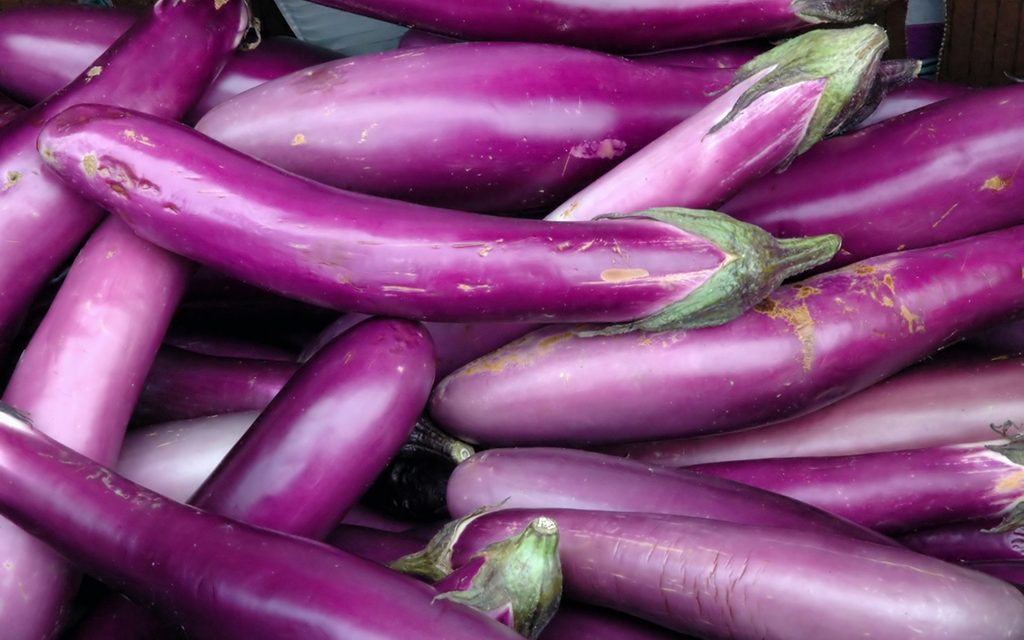This Type of Eggplant Will Lend a Sweeter Edge to Your Dishes

Learn more about the nightshade, what to look for when buying one and how to cook it with these helpful tips.
Much like their tomato cousins, eggplants are at the centre of a very important debate: Are they fruit, or are they vegetables? Though they’re often mistaken as the latter, eggplants are actually berries and part of the nightshade family, which includes tomatoes and potatoes. However, that doesn’t mean you can’t treat them like veggies—they can be made into a spread or mixed with pasta—and their versatility makes them the perfect go-to ingredient.
The big purple ones you’re familiar with aren’t the only type out there—meet the Chinese eggplant.
What is a Chinese eggplant?
Chinese eggplants are long and thin with vibrant lavender skin and white flesh and can appear either crooked or straight. They taste mildly sweet and hold up when cooked.
What other types of eggplant are there?
When you see the word “eggplant,” that’s usually referring to the large varieties most often found in grocery stores, which are called globes. They’re hefty, have little green caps, and tend to be more bitter, meaty and flavourful.
There are many other varieties of eggplant, too—graffiti, Indian, Japanese and Italian, to name a few. While each is delicious in its own right, unique properties make a certain type best suited for certain dishes. But before adding to your recipe, make sure you get rid of germs and pesticides with these smart tips.
What’s the difference between eggplant and Chinese eggplant?
Chinese eggplants have fewer seeds than globes, which reduces their bitterness. And they have a thin skin. While they can be substituted for each other, globes may be less sweet, influencing the outcome of the final dish.
How do you pick the best Chinese eggplant?
Picking the right Chinese eggplant is an art. Look for ones that are firm and have shiny skin, and avoid any blemishes or soft spots. This means that they’ll be young, tender and full of flavour.
Do you need to salt Chinese eggplant?
Because they have fewer seeds, Chinese eggplants are less bitter than globes and do not need to be salted. Salt is used to draw out bitterness, but this variety is naturally sweet. In fact, if an eggplant is picked fresh, it most likely doesn’t need salt, no matter the variety.
What can I make with Chinese eggplant?
Try the recipe below. It calls for any type of eggplant—but the Chinese eggplant’s inherent sweetness will be accentuated by the lime juice and sesame, letting the spices shine.

Lime and Sesame Grilled Eggplant
Prep/Total Time: 20 min.
Makes: 6 servings
Ingredients
- 3 tbsp lime juice
- 1 tbsp sesame oil
- 1-1/2 tsp reduced-sodium soy sauce
- 1 garlic clove, minced
- 1/2 tsp grated fresh ginger root or 1/4 tsp ground ginger
- 1/2 tsp salt
- 1/8 tsp pepper
- 1 medium eggplant (1-1/4 pounds) cut lengthwise into 1/2-inch slices
- 2 tsp honey
- 1/8 tsp crushed red pepper
- Thinly sliced green onion and sesame seeds
Step 1: Get grilling
In a small bowl, whisk the first seven ingredients until blended. Then, brush 2 tablespoons of the juice mixture over both sides of the eggplant slices. Grill, covered, over medium heat 4-6 minutes on each side, or until tender.
Step 2: Add a garnish
Transfer eggplant to a serving plate. Stir honey and pepper flakes into the remaining juice mixture and drizzle it over the eggplant. Sprinkle with green onion and sesame seeds.
Nutrition Facts
1 serving: 50 calories, 2g fat (0 saturated fat), 0 cholesterol, 246mg sodium, 7g carbohydrate (4g sugars, 2g fibre), 1g protein.
Next, check out the most common nightshade vegetables myths.




